| Autocar 4561
Testbericht
aus
Autocar
Vol 161 No 4561
week
ending
26 May 1984
S. 22 - 27
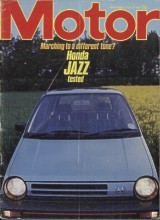
|
Auto Test
Honda Jazz
£ 4,315
| Max: 88
mph |
0 - 60
mph: 13.4 sec |
35.3 mpg overall
FOR:
- Useful
height from unusual shape
- Nippy
performance
- Light
controls
- Accurate
steering
AGAINST:
- Engine
noise intrusive
- Choppy
ride
- Limited
rear legroom
- Seats
lack support
|
|
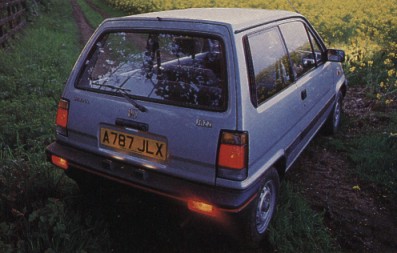 |
Small
but tall
New kind of town car from Honda has full Autotest
Honda have something of a
reputation of marching to the beat of a different
drummer when it comes to the design and
engineering of their small cars. There were the
S600 and S800 sports cars, whose power units
seemed to have the rev-ability of formula 1
engines, the minuscule N360, an early attempt at
a town car with its two-cylinder engine, and the
slightly larger N600, more conventional in
appearance, but still with two cylinders of
motive power.
The Honda Jazz, then, is
following something of a family tradition, and
even though its mechanicals are orthodox enough,
the stares and double-takes of motorists and
pedestrians alike soon confirm that Honda's
latest attempt at an urban car looks like nothing
else presently on Britain's roads. As discussed
in Technical Focus, the Jazz employs the
so-called "tall-car" principle to give
occupants a higher seating position, with
attendant gains in visibility and ease of entry
and exit, in a compact, easily manoeuvred
package.
|
| TECHNICAL
FOCUS |
| The design
concept for the Jazz accoring to Honda
engineers, was based upon a sphere rather
than a cube, and it most definitely
shows. The Jazz is a member of the
increasingly in-vogue
"tall-car" fraternity and more
closely resembles a Nissan Prairie than
any other vehicle. Clearly, the most
notable feature of the Jazz is its
unusual styling. The bonnet and
windscreen are steeply raked - the latter
at 55 deg to the vertical - and flow into
the asymmetrically shaped grille. The
large front and rear bumpers-cum-aprons
are one-piece polypropylene. The rear of the car
follows a nearly vertical line with the
roof itself terminating in a small,
upswept spolier while the back wheels are
positioned so far rearwards that there is
virtually no overhang. A drag coefficient
of 0.40 is not terribly impressive by
current standards, but it must be
remembered that small cars are more
difficult to make aerodynamically
efficient than larger ones. The Jazzz
incorporates a number of windcheating
touches, including the windscreen glass
and rear side windows glazed directly to
the body, horizontal louvres in the rear
bumper to help reduce under-body pressure
build-up, plus flush door handles and
side mouldings.
More interesting,
though, are the possible practical
benefits to be derived from a tall-car
design. Because of the higher roof line,
the driver and front passenger sit 2 3/4
in. higher than in a more conventional
hatchback like the Civic - with attendant
gains in visibility. In fact, the
"maximization of inner space"
was a high priority within the compact
external dimensions of the Jazz. To this
end, the location of the transverse
engine and strut-type front suspension
system were designed to intrude as little
as possible into the interior of the car.
Similarly, the position of the rear
wheelarches and slimline coil
spring-strut (seperately mounted)
suspension means boot capacity is only
marginally infringed upon. In addition,
the mouldings for the headlining and door
linings have been designed to contribute
extra inches of unsable space.
The short tail of
the Jazz means there is less luggage
space than in some of the car's
competitors (6.9 cu ft. is the
manufacturer's quoted figure), but the
rear seat can be folded into a vertical
position behind the front seats to
provide a useful cargo area.
|
 |
Conventional
hatchback |
Honda
Jazz |
| Aside from
the obvious improvement in
visiblity, one of the biggest
gains from a "tall-car"
design such as the Jazz is the
ease of entry and exit -
particularly appropriate for a
vehicle spending much of its
working life in town |
|
|
| Putting
the pros and cons of such designs to one side for
the moment, though, how does the Jazz perform?
It's light at 1,556 lb, despite all that
weight-adding glass, and the 56 bhp, 1,231 c. c.
engine propels it to 60 mph in a respectable 13.4
sec. In fact, it displays useful gains in all the
major performance indicators over the last
comparable Honda Civic tested, a 1,238 c. c.
five-door model (8 April 1978). It is also very
much in contention, as far as performance is
concerned, with the other small hatchbacks
against which it is clearly pitched. With a bore and stroke of 66.0 mm
x 90.0 mm, the engine in the Jazz is clearly
undersquare. To make it more compact, this
variant of the Civic power unit is fitted with a
counterflow rather than crossflow cylinder head,
works on a 10.2-to-1 compression ratio and,
according to Honda engineers, is intended
"to generate high torque at low rpm, to cope
with the stop-start of city traffic, while
retaining good fuel economy."
In our experience with
the Jazz, the engine certainly seems to
accomplish those aims, but it is also a
noticeably responsive, pokey unit which revs
freely and willingly to the accompaniment of a
rorty induction rasp - great fun around town, but
it could conceivably become tiresome in the
course of a long, fast run.
Arguably the most unusual
aspect of the UK-specification Jazz is the choice
of gear ratios. On paper, the mph per 1,000 rpm
figures for third, fourth and fifth gears of
13.90, 18.62 and 22.09 respectively, seem quite
closely spaced; substantiated by maxima in the
gears of 83, 88 an 86 mph. There is very little
to choose between them, other than the engine
revs at which they achieve those speeds. This
phenomenon was noted by Autocar testers
on previous five-speed Honda Civics.
|
| Economy |
| In
spite of the eager nature of the engine, the
apparently strange choice of gearing and the
aerodynamically unclean body with its 0.40 drag
coefficient, the Jazz recorded 35.3 mpg overall.
That isn't particularly impressive fuel
consumption figure when compared with, say, the
40.6 mpg of the Mini City, 41.3 mpg for the
Renault 5TL or 43.7 mpg for the Nissan Micra -
all cars against which the Honda could be said to
compete - but it is a reasonable figure. Our
consumption figures varied between a worst of
32.9 mpg, after testing at MIRA, and 39.1 mpg,
after a spell of less rigorous use around town
and on medium-distance commuting trips over a
variety of roads. Oil
consumption during the test period was negligible
with no apparent change in the level indicated on
the dipstick.
|
| Refinement |
| The
Jazz has a lot of good qualities. |
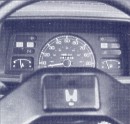
Large
speedo dominates instrument panel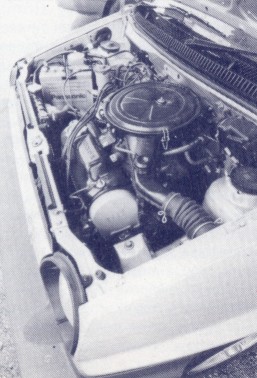
56 bhp
engine gives class-beating if unrefined
performance
|

Headroom
not as good as it looks and lots of painted metal
in cabin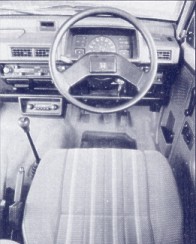
Upright
driving position; plenty of space for oddments
|
| MOTOR
ROAD TEST No 31/84 Honda Jazz
|
| PERFORMANCE |
| WEATHER CONDITIONS |
Wind
Temperature
Barometer
Surface |
15 mph
70 deg F/21 deg C
29.4 in Hg 996 mbar
Dry tarmacadam |
| |
| MAXIMUM SPEEDS |
| |
mph |
kph |
Banked Circuit
Best ¼ mile |
89.1
94.7 |
143.4
152.4 |
| Terminal speeds: |
|
|
|
at ¼ mile
at kilometre |
71
83 |
114
134 |
| Speeds in gears (at 5,500
rpm): |
|
|
|
1st
2nd
3rd |
27
52
75 |
43
84
121 |
| |
| ACCELERATION FROM REST |
| mph |
sec |
|
kph |
sec |
| 0 - 30 |
3.7 |
|
0 - 40 |
2.7 |
| 0 - 40 |
5.8 |
|
0 - 60 |
5.3 |
| 0 - 50 |
8.7 |
|
0 - 80 |
8.6 |
| 0 - 60 |
12.7 |
|
0 - 100 |
13.8 |
| 0 - 70 |
18.2 |
|
0 - 120 |
22.4 |
| 0 - 80 |
29.8 |
|
|
|
| Standing ¼ |
18.9 |
|
Standing km |
36.0 |
| |
| ACCELERATION IN TOP |
| mph |
sec |
|
kph |
sec |
| 20 - 40 |
13.3 |
|
40 - 60 |
8.2 |
| 30 - 50 |
14.5 |
|
60 - 80 |
9.3 |
| 40 - 60 |
17.0 |
|
80 - 100 |
11.8 |
| 50 - 70 |
22.4 |
|
100 - 120 |
19.0 |
| |
| ACCELERATION IN 4TH |
| mph |
sec |
|
kph |
sec |
| 20 - 40 |
10.2 |
|
40 - 60 |
6.3 |
| 30 - 50 |
10.8 |
|
60 - 80 |
7.0 |
| 40 - 60 |
11.4 |
|
80 - 100 |
8.0 |
| 50 - 70 |
14.2 |
|
100 - 120 |
11.1 |
| 60 - 80 |
20.6 |
|
|
|
| |
| FUEL CONSUMPTION |
| Touring* |
48.2 mpg
5.9 litres/100 km |
| Overall |
40.8 mpg
6.9 litres/100 km |
| Govt tests |
45.6 mpg (urban)
57.6 mpg (56 mph)
40.9 mpg (75 mph) |
| Fuel
grade |
97
octane |
| Tank capacity |
9.0 galls
41 litres |

mph |
| Max range |
434 miles
698 km |
| Test distance |
658 miles
1,059 km |
| * An
estimated fuel consumption computed from
the theoretical consumption at a steady
speed midway between 30 mph and the car's
maximum, less 5 per cent. |
| |
| NOISE |
dBA |
|
Motor rating* |
|
| 30
mph |
68 |
|
14 |
|
| 50
mph |
72 |
|
18 |
|
| 70
mph |
80 |
|
32 |
|
| Maximumº |
86 |
|
48 |
|
| * A
rating where 1 = 30 dBA and 100 = 96 dBA,
and where double the number means double
the loudness |
| º
Peak noise level under full-throttle
acceleration in 2nd |
| |
| SPEEDOMETER
(mph) |
| True
mph |
30 |
40 |
50 |
60 |
70 |
80 |
| Speedo |
29 |
39 |
48 |
57 |
66 |
75 |
| Distance
recorder: 1.0 per cent fast |
| |
| WEIGHT |
cwt |
|
kg |
|
| Unladen
weight* |
13.8 |
|
700 |
|
| Weight
as tested |
17.1 |
|
870 |
|
| *
with fuel for approx 50 miles |
Performance tests
carried out by Motor's
staff at the Motor Industry Research Association
proving ground, Lindley.
Test Data: World Copyright reserved by Motor.
|
| GENERAL
SPECIFICATION |
| |
| ENGINE |
| Cylinders |
4 in-line |
| Capacity |
1,231 cc (75 cu
in) |
| Bore/stroke |
66/90
mm
(2.60/3.54 in) |
| Cooling |
Water |
| Block |
Aluminium alloy |
| Head |
Aluminium alloy |
| Valves |
Sohc |
| Cam drive |
Toothed belt |
| Compression |
10.2 : 1 |
| Carburetter |
Keihin twin
choke |
| Ignition |
Contactless |
| Bearings |
5 main |
| Max power |
56 bhp (DIN) at
5,000 rpm |
| Max torque |
68.7 lb ft (DIN)
at 3,500 rpm |
| |
| TRANSMISSION |
| Type |
5-speed manual |
| Clutch dia |
N/A |
| Actuation |
Cable |
| Internal
ratios and mph/1,000 rpm |
| Top |
0.655/21.8 |
| 4th |
0.777/18.4 |
| 3rd |
1.041/13.7 |
| 2nd |
1.526/9.4 |
| 1st |
2.916/4.9 |
| Rev |
2.916 |
| Final drive |
4.266 |
| |
| BODY/CHASSIS |
| Construction |
Unitary, all
steel |
| Protection |
Six-year
anti-corrosion warranty |
| |
| SUSPENSION |
| Front |
Independent by
MacPherson struts, coil springs |
| Rear |
Semi-trailing
arms, coil springs |
| |
| STEERING |
| Type |
Rack and pinion |
| Assistance |
None |
| |
| BRAKES |
| Front |
Discs, 6.9 in
dia |
| Rear |
Drums, 7.1 in
dia |
| Park |
On rear |
| Servo |
Yes |
| Circuit |
Diagonal split |
| Rear valve |
Yes |
| Adjustment |
Automatic |
| |
| WHEELS/TYRES |
| Type |
Pressed steel 4
J x 12 |
| Tyres |
145 SR 12 |
| Pressures |
26/26
psi F/R (normal)
26/28 psi F/R (full load/high speed) |
| |
| ELECTRICAL |
| Battery |
47 Ah |
| Earth |
Negative |
| Generator |
Alternator, 45
Amp |
| Fuses |
17 |
| Headlights |
|
| type |
Halogen |
| dip |
110 W total |
| main |
120 W total |
|
| Make: Honda. Model:
Jazz. Maker: Honda Motor Co.
6-27-8 Chome, Jingumae, Shibuya-ku, Tokyo, Japan.
UK Concessionaires: Honda (UK)
Ltd, 4 Power Road, Chiswick, London W4 5YT. Tel.
01-995 9381. Price: £ 3,463.55
basic, plus £ 288.62 Car Tax, plus £ 562.83 VAT
equals £ 4,315.00 total. |
| The Rivals Other possible rivals
include the Ford Fiesta Popular 1.1 (£ 4,319),
Renault 5 GTL (£ 4,520), Suzuki SA 310 GL (£
3,999), Talbot Samba 1.1 GL (£ 4,395) and Toyota
Starlet 1.0 GL (£ 4,267).
|
 |
| Power, bhp/rpm |
56/5,000 |
| Torque, lb
ft/rpm |
69/3,500 |
| Tyres |
145
SR 12 |
| Weight, cwt |
13.8 |
| Max speed, mph |
89.1 |
| 0 - 60 mph, sec |
12.7 |
| 30 - 50 mph in
4th, sec |
10.8 |
| Overall mpg |
40.8 |
| Touring mpg |
48.2 |
| Fuel grade,
stars |
4 |
| Boot capacity,
cu ft |
4.8 |
| Test Date |
June
30, 1984 |
| |
| The
Honda Jazz is very easy to drive and has
a larger than usual engine size for the
class, giving both excellent performance
and class-beating economy. But
accommodation is very limited, refinement
poor, it is starkly trimmed and the ride
is uncomfortably harsh; furthermore
several items of expected equipment are
missing - though it does boast a
detachable sunroof. It is expensive, but
its "tall build" design does
represent an interesting and eye catching
approach to the concept of a town car. |
|
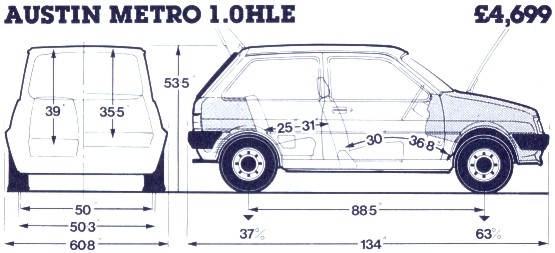 |
| Power, bhp/rpm |
46/5,500 |
| Torque, lb
ft/rpm |
54/3,250 |
| Tyres |
135
SR 12 |
| Weight, cwt |
14.8 |
| Max speed, mph |
86.0 |
| 0 - 60 mph, sec |
18.2 |
| 30 - 50 mph in
4th, sec |
17.2 |
| Overall mpg |
39.7 |
| Touring mpg |
51.0 |
| Fuel grade,
stars |
4 |
| Boot capacity,
cu ft |
8.4 |
| Test Date |
October
15, 1983 |
| |
| In
its latest even more frugal version, the
Metro combines adequate performance with
fine fuel consumption, and a versatile,
roomy interior within a compact exterior
providing exceptional visibility. Other
strong points include handling, brakes,
gearchange, instruments, heating, and
refined cruising. Despite comfy new
seats, the bus-like driving position
won't suit all drivers, and some aspects
of the ride are disappointing, but
overall a fine little car. |
|
 |
| Power, bhp/rpm |
51/5,600 |
| Torque, lb
ft/rpm |
56/3,200 |
| Tyres |
155
SR 13 |
| Weight, cwt |
14.6 |
| Max speed, mph |
84.6 |
| 0 - 60 mph, sec |
16.7 |
| 30 - 50 mph in
4th, sec |
15.2 |
| Overall mpg |
37.3 |
| Touring mpg |
47.0 |
| Fuel grade,
stars |
2 |
| Boot capacity,
cu ft |
5.8 |
| Test Date |
May
7, 1983 |
| |
| Second-generation
Charade in its most expensive version is
outstandingly well equipped at the price,
and delivers competitive performance with
very good economy. Unusual three-cylinder
engine sounds odd at low speeds but revs
smoothly and is relaxed on the M-way
thanks to tall five-speed gearing. Good
driving position is a plus point and the
Charade is reasonably competitive in most
other areas of its design, though its
ultimate cargo-carrying capacity is
limited. |
|
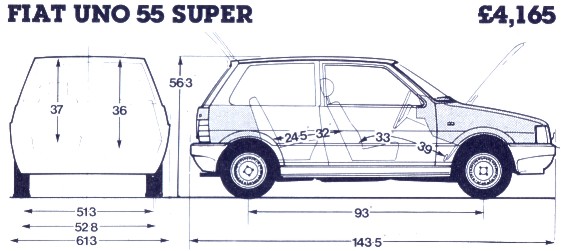 |
| Power, bhp/rpm |
55/5,600 |
| Torque, lb
ft/rpm |
64/2,900 |
| Tyres |
135
SR 13 |
| Weight, cwt |
14.2 |
| Max speed, mph |
93.4 |
| 0 - 60 mph, sec |
14.2 |
| 30 - 50 mph in
4th, sec |
12.7 |
| Overall mpg |
35.1 |
| Touring mpg |
44.7 |
| Fuel grade,
stars |
4 |
| Boot capacity,
cu ft |
9.8 |
| Test Date |
June
18, 1983 |
| |
| Tested
by us in four-speed Comfort form, the Uno
Super has a particularly spacious
interior and competitive pricing in its
favour. Performance, ride, handling and
visibility are other virtues. Seat
comfort could be improved and though the
gearchange is one of Fiat's better
efforts it is still not a strong point.
With a five-speed gearbox, the Super
should give better economy than the
Comfort, if not in the same league as the
Honda. It is well equipped at the price. |
|
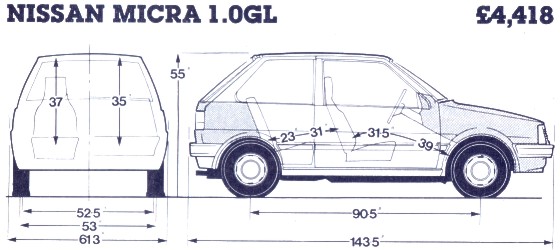 |
| Power, bhp/rpm |
55/6,000 |
| Torque, lb
ft/rpm |
56/3,000 |
| Tyres |
145
SR 12 |
| Weight, cwt |
12.9 |
| Max speed, mph |
87.4 |
| 0 - 60 mph, sec |
14.0 |
| 30 - 50 mph in
4th, sec |
13.0 |
| Overall mpg |
37.0 |
| Touring mpg |
52.6 |
| Fuel grade,
stars |
4 |
| Boot capacity,
cu ft |
7.4 |
| Test Date |
July
23, 1983 |
| |
| Equipped
with a long-legged five speed
transmission and the more powerful
version (55 bhp) of Nissan's new 1-litre
engine, the Micra GL is one of the most
economical superminis, but it cannot
quite match the Honda's performance.
Further virtues are its capable handling,
slick gearchange, comfortable driving
position and good visibility. Minor
drawbacks are restricted rear seat
accommodation and mediocre heating and
ventilation system but, overall, it is a
very effective contender. |
|
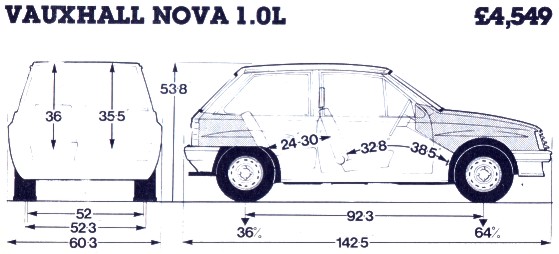 |
| Power, bhp/rpm |
45/5,400 |
| Torque, lb
ft/rpm |
50/2,600 |
| Tyres |
135
SR 13 |
| Weight, cwt |
14.5 |
| Max speed, mph |
84.3 |
| 0 - 60 mph, sec |
18.5 |
| 30 - 50 mph in
4th, sec |
17.5 |
| Overall mpg |
35.3 |
| Touring mpg |
47.9 |
| Fuel grade,
stars |
4 |
| Boot capacity,
cu ft |
7.8 |
| Test Date |
May
14, 1983 |
| |
| GM's
supermini is a typically competent all
rounder which doesn't excel in any
particular area, but has a combination of
virtues which place it among the best in
its class. Handling, brakes, gearchange,
accommodation, visibility and refinement
are all strong points, but in 1.0 litre
form, performance and economy are only
fair. Heating, ventilation and finish are
only average and the ride is poor. It is
competitively priced. |
|
|















